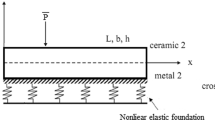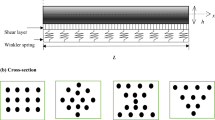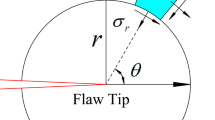Abstract
The effect of the end conditions, i.e. clamped-clamped vs. simply-supported ends on the initial postbuckling and growth behavior of delaminations in plates in studied. The study does not impose any restrictive assumptions regarding the delamination thickness and plate length. First, a closed form solution for the mode mixity, energy release rate and deformation quantities is derived for the case of a clamped-clamped delaminated plate, which complements the already existing solution for a delaminated simply-supported plate. A perturbation procedure is followed, which is based on an asymptotic expansion of the load and deformation quantities in terms of the distortion parameter of the delaminated layer, the latter being considered a compressive elastica. The additional complication in the clamped-clamped case arises because now the amplitude at the clamped end needs to be expanded in terms of the distortion parameter of the delaminated part, in addition to the amplitude at the common section and the distortion parameter of the base plate. The effects of the end conditions on the growth behavior are found to depend on the relative location of the delamination through the thickness. For the same plate length and thickness and the same delamination length and applied strain, delaminations located closer to the surface exhibit nearly the same energy release rate and mode mixity either in a clamped-clamped or a simply supported configuration. However, in delaminations located further away from the surface, for the same applied strain, the energy release rate is larger and there is also a higher mode II component in the simply-supported case. Moreover, the mid-point transverse displacement of the delaminated layer as well as that of the substrate part, is larger in the simply supported case. The same major trend that has been observed in the simply supported case, i.e. the increased growth resistance of the delaminations located near the surface relative to the ones located further inside the plate, is also observed in the clamped-clamped case.
Similar content being viewed by others
References
G.A.Kardomateas and D.W.Schmueser, AIAA Journal 26 (1988) 337–343.
H.Chai, C.D.Babcock and W.G.Knauss, International Journal of Solids and Structures 17 (1981) 1069–1083.
G.J.Simitses, S.Sallam and W.L.Yin, AIAA Journal 23 (1985) 1437–1444.
S.S.Wang, N.M.Zahlan and H.Suemasu, Journal of Composite Materials 19 (1985) 296–316.
A.G.Evans and J.W.Hutchinson, International Journal of Solids and Structures 20 (1984) 455–466.
H.Chai and C.D.Babcock, Journal of Composite Materials 19 (1985) 67–97.
I.Vardoulakis and E.Papamichos, International Journal of Rock Mechanies, Mineral Science and Geomechanics Abstracts 28 (1991) 163–173.
G.A.Kardomateas, AIAA Journal 27 (1989) 624–631.
I.Sheinman and M.Adan, Journal of Applied Mechanics (ASME) 54 (1987) 558–562.
G.A.Kardomateas, Journal of Applied Mechanics (ASME) 60 (1993) 903–910.
Z.Suo and J.W.Hutchinson, International Journal of Fracture 43 (1990) 1–18.
K.-F.Nilsson and B.Storåkers, Journal of Applied Mechanics (ASME) 59 (1992) 530–538.
J.W. Hutchinson and Z. Suo, in Advances in Applied Mechanics, Academic Press, vol. 29 (1992) 63–191.
S.J.Britvek, The Stability of Elastic Systems, Pergamon, New York (1973).
M.J.D.Powell, in Numerical Methods for Nonlinear Algebraic Equations, P.Rabinowitz (ed.), Gordon and Breach, New York (1970) 87–161.
M.D.Thouless, A.G.Evans, M.F.Ashby and J.W.Hutchinson, Acta Metallurgica 35 (1987) 1333–1341.
H.Chai, International Journal of Fracture 46 (1990) 237–256.
J.Dundurs, Mathematical Theory of Dislocations, American Society of Mechanical Engineering, New York (1969) 70–115.
G.A.Kardomateas, in Interlaminar Fracture in Composites, ‘Key Engineering Materials’ series, Trans Tech Publications, Ltd., Switzerland (1989) 269–284.
G.A.Kardomateas, Journal of Composites Technology and Research (ASTM) 12 (1990) 85–90.
Author information
Authors and Affiliations
Rights and permissions
About this article
Cite this article
Kardomateas, G.A., Pelegri, A.A. Growth behavior of internal delaminations in composite beam/plates under compression: effect of the end conditions. Int J Fract 75, 49–67 (1996). https://doi.org/10.1007/BF00018525
Received:
Accepted:
Issue Date:
DOI: https://doi.org/10.1007/BF00018525




